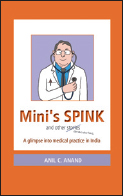Translate this page into:
Mini's SPINK and Other Anecdotes––A glimpse into medical practice in India
Corresponding Author:
Sanjay A Pai
Department of Pathology and Laboratory Medicine, Columbia Asia Referral Hospital, Bengaluru, Karnataka
India
sanjayapai@gmail.com
| How to cite this article: Pai SA. Mini's SPINK and Other Anecdotes––A glimpse into medical practice in India. Natl Med J India 2018;31:121-122 |

Anil C. Anand. Byword Books, New Delhi. 258pp, ? 299. ISBN 978-81-8193-126-9.
The NationalMedical Journal of India is unique among medical journals, in that it offers considerable space for personal and opinion pieces. This allows it to live up to its motto of ‘Inform, instruct and entertain’. The ‘Letters from…' series and the ‘Speaking for myself columns do all of that. I, and many others, enjoy humour, reflection and knowledge in these columns. In particular, Dr A.C. Anand’s regular columns stand out. Doctors and lay people can read these essays with equal pleasure.
Having read all of his essays over the past two decades, it gave me great pleasure to re-read them and to discover how they are as true and relevant today as when they were first written. Most of the essays are re-printed from the NationalMedical Journal of India, except for one from Tropical Gastroenterology. Dr Anand adopts a Socratic approach: much of the time, he asks the question and the protagonist educates him (and us) about the modern ways of medicine. The protagonist may be a wise colleague or a young impish student. On occasion, however, Dr Anand himself elaborates on his views on the practice of modern medicine in India. Using this format, the author finds contradictions in our dogma.
What is unique about the practice of medicine in our nation? All of us know the answer to that question, of course—yet, unless one gives it serious thought, one does not realize the extent of the change in thought and practice over the past quarter century—and not all for the better! Dr Anand’s essays tell us, among other things, about how admissions into medical school and for postgraduation are doctored, how the setting up of medical colleges itself is manipulated, the introduction of evidence-based medicine, corporatization of medicine, the arrival of clinical research organizations (CROs) and the shift from investigator- based research to pharma company-sponsored research and clinical trials. He uses this forum to inform the interested reader about ethical quandaries in some of our advances—those in genetic testing, and in living donor transplants, for instance. Evidence- based medicine seems to be a particular favourite—many essays revolve around this topic, and it is an indication of the author’s insight into the subject, that there is no repetition of his ideas in the essays. Yoga, ragging, referral fees, etc. form some of the other subjects of his thoughts. This is not to say that I agree with everything that he or the protagonist says (e.g. the statement ‘corporate hospitals have only one aim and that is to generate profit’. Even given the disclaimer that I work in a private hospital, I find this a bit of a stretch).
I must, however, admit to repeatedly getting exasperated about one thing—the lack of references at the end of the chapters. The author states that it has been done ‘to maintain readability’—but quite simply, including references does not lead to loss in readability in the first place, and it is unreasonable to expect readers who still read and enjoy books (‘hard copy’) to later on look up exact references on the net.
In his preface, Dr Anand writes that he is now often better known for these writings of his, rather than his research work. He need not worry on that count. His research work is well known— one of which is the paper that questions the existence of non- dysenteric intestinal amoebiasis (Lancet 1997;349:89-92). However, as he himself quotes in one of his essays (p. 144) '… half of what we practice today will be proven wrong in a few years’ time’. Thus, it is possible that half of his well-performed research will be proven wrong in the future. That is unlikely to hold good for the articles in this book, however.
An Op-Ed article in The Times of India, Bengaluru edition (‘Why doctors need humanities’ by Anand Krishnan, 28 February 2017, p. 12), stated that ‘medical school attracts those who are of left brain, but then proceeds to atrophy what is left of their right brain’. Because our universities do not teach our medical students the spirit of enquiry, I believe that every medical student in India must read this book to learn one of the most important things in learning medicine—to question dogma.
Fulltext Views
796
PDF downloads
941




